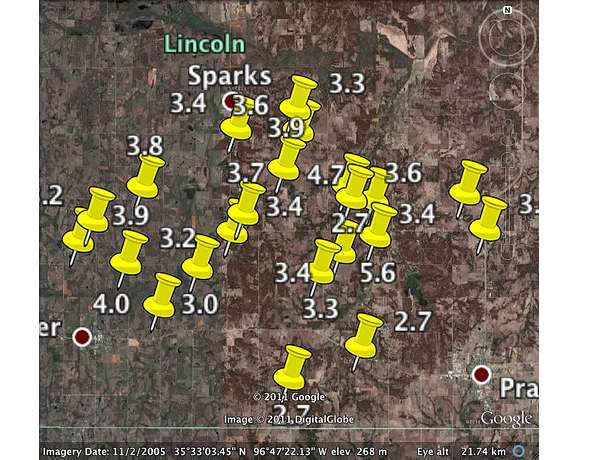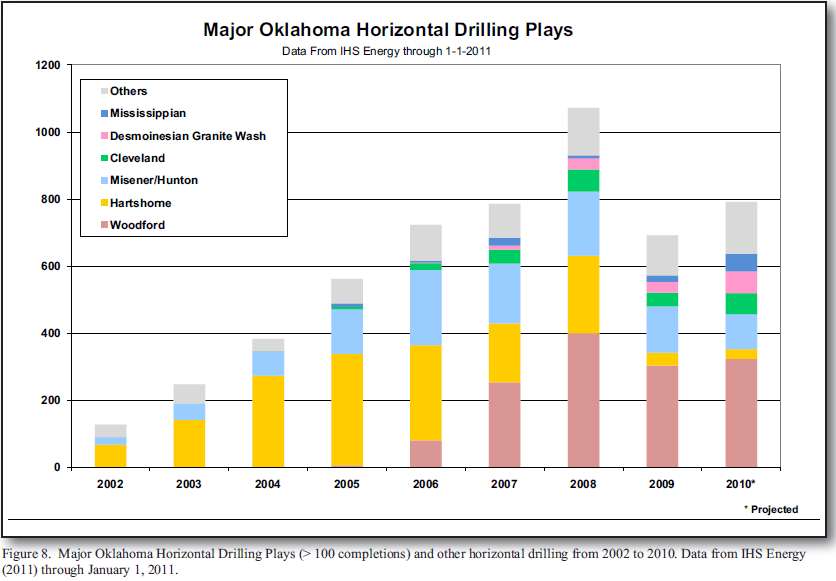What caused the M5.6 Sunday Nov. 6 quake, the strongest earthquake in Oklahoma's history? Was it a random natural event? Was it directly caused by hydrofracturing (fracking) or oil and gas activities? Was is caused by a combination of natural and human activities? A large number of confusing and conflicting reports have been written by journalists and bloggers. This post is my effort to separate the facts, the speculation and the misinformation. I successfully defended my PhD dissertation on geochemical changes associated with earthquakes on San Jacinto fault in southern California many years ago, so I have some expertise on the topic.
Oklahoma Geologic Survey's recording of M5.6 earthquake.
Image may be NSFW.
Clik here to view.
1. Fracking for oil and gas did not cause the M5.6 earthquake.
First, fracking involves relatively small amounts of energy. A M5.6 earthquake has the energy of about 38 thousand tons of TNT. A typical quake caused by fracking is insignificant. The amount of energy involved in a typical earthquake caused by fracking,
"is the equivalent to a gallon of milk falling off the kitchen counter," said Stanford University geophysicist Mark Zoback.
Moreover, the oil and gas play above the hypocenter (center at depth) of the earthquake is being dewatered, not hydrofractured. PDF Dewatering is pretty much the opposite of fracking. Additionally the oil bearing formation is less than a mile deep while the earthquake's hypocenter was about 3 miles down.
2. Evidence suggests that the M5.6 event was unlikely to occur at this time by natural processes alone.
This part of Oklahoma had virtually no seismic activity before 2006. The ancient "Ancestral Rocky Mountain" fault system that the earthquake took place on appeared to be inactive. Image may be NSFW.
Clik here to view.
Since 2006, when massive dewatering operations began for oil and gas production, the number of earthquakes has gone way up. There appears to be a strong correlation between oil and gas activities and seismicity in space and time.
According to the Oklahoma Geological Survey, seismic activity has increased 10 times more than normal since 2009. Although there are some deep-lying fault lines beneath the state’s surface, earthquakes are not a typical occurrence in the Sooner State. Unlike California and Japan, which are both locations prone to earthquakes, Oklahoma does not sit atop two fractious tectonic plates. So what is causing all these earthquakes?Source: Planetsave (http://s.tt/...)
Image may be NSFW.
Clik here to view.
Oklahoma Geological Survey seismologist Austin Holland said there have%been at least 40 aftershocks recorded since the initial event.Holland spent Saturday installing several temporary seismic stations in and around Prague. He said the quake was the result of movement along the Seminole Uplift Structure.
“It’s a very complicated fault structure, but it is very prominent in its geological signature,” Holland said.
Image may be NSFW.
Clik here to view.Holland said the fault has been active since early Feb. 10. He said Lincoln County, where the fault lies, can experience between 10 and 30 quakes per month.
Read more: http://newsok.com/...
Oil and gas production activities in Oklahoma have gone way up since 2005. There has been intense oil production activity in the Hunton formation above the hypocenter of the earthquake swarm in Lincoln County.
Image may be NSFW.
Clik here to view.
3. Deep injection of waste water from massive dewatering operations to produce oil and gas appears to have weakened the existing fault system and triggered the earthquake well ahead of the time it might have naturally occurred.
Massive amounts of waste water from oil operations are being disposed of in deep formations below the oil production zone. Linclon county is peppered with deep injection wells.
In Lincoln County, where most of this weekend's earthquakes were centered, there are 181 injection wells, according to an official from the Oklahoma Corporation Commission, the agency which oversees oil and gas production in the state.
Deep waste injection wells were discovered to trigger earthquakes in Colorado near Denver. Since then, deep waste water injection wells have been found to trigger earthquakes in other locations where stressed faults had been weakened by fluid injection. A recent report "Examination of Possibly Induced Seismicity from Hydraulic Fracturing in the Eola Field, Garvin County, Oklahoma" PDF by Oklahoma Geological Survey seismologist Austin Holland, on another swarm of earthquakes in Oklahoma, discusses induced earthquakes in detail and provides a long list of references on induced seismicity.
Anthropogenic triggered seismicity has regained scientific and media attention recently. Recent earthquakes in the Dallas-Fort Worth area (Frohlich et al.,2011) and earthquakes near Guy, Arkansas, have dramatically raised this issue to some significance. Cases of clear anthropogenically-triggered seismicity from fluid injection are well documented with correlations between the number of earthquakes in an area and injection, specifically injection pressures, with earthquakes occurring very close to the well. Examples of clearly induced seismicity include the Rocky Mountain Arsenal (Hsieh and Bredehoeft, 1981), Rangely, Colorado (Raleigh et al.,1972; Raleigh et al., 1976), Paradox Valley, Colorado (Ake et al., 2005), and the KTB Deep Well in Germany (Jost et al., 1995; Baisch et al., 2002).There are also many examples from enhanced geothermal systems where there is a clear correlation between injection and earthquakes. Examples of these include, but are not limited to Frenton Hill, New Mexico (Fehler et al., 1998), Basel, Switzerland (Deichmann and Giardini, 2009), Cooper Basin, Australia (Baisch et al., 2006), and Soultz, France (Horalek et al., 2010).
Increasing water or fluid pressure in a fault zone tends to exert increasing force pushing the sides of the fault apart, weakening it. Because rocks over large parts of north America are strained, the stored strain may be released as earthquakes when the fault is weakened to the breaking point by increasing water pressure. Thus, deep injection wells can trigger earthquakes.
There is strong evidence that enormous amounts of waste water have been injected into deep formations near where the earthquakes took place. Production of oil and gas by dewatering is a complex process because very large amounts of water must be processed to extract modest amounts of oil and gas. Because the producing formation, the Hunton Dolomite is highly permeable and had highly pressured water when dewatering began, production by dewatering produces huge amounts of waste water that cannot be disposed of near the surface or near aquifers. Therefore, it is disposed several miles deep, below the producing formation. Impermeable formations above the injection formation keep the waste water from contaminating aquifers and oil bearing formations. They also act like a lid to keep the pressure on. However, this water will enter fault zones and raise the fluid pressure in faults over time.
There has been enough time, 5 years, for the water pressure to increase over a large area and down to the depth the point where the rupture began 3 miles deep. Hydrostatic pressure increases caused by filling dams, such as Oroville dam, has been determined the probable trigger of earthquakes that happened 1 to 10 years after dam filling started. The injection of huge amounts of waste water into deep formations in central Oklahoma would trigger earthquakes in a similar manner.
Central Oklahoma Hunton Dewater Resource Play:The dewatering process is one which allows for extensive oil and gas production in fields generally known to contain oil and gas but bypassed by certain other operators due to high water saturation of reservoirs. Dewatering is simply the removal of these large volumes of water, which in turn reduces the pressure on trapped hydrocarbons and allows them to move to the wellbore (a physical hole that makes up the well), for recovery. The Hunton reservoir is one of the most prolific hydrocarbon reservoirs in Oklahoma, containing substantial amounts of oil, natural gas and water. Special Energy Corporation (SEC) is the major operator of the play focusing on dewatering the central Oklahoma Hunton reservoir, and is one of the pioneers of this dewatering technology.
In central Oklahoma the dewater play has produced over 12.8 million barrels of oil and 168 Billion Cubic Feet (BCF) of gas from the Hunton reservoir. This equates to over $1.6 billion dollars in revenue using an average of $50 per barrel of oil and $6 per Thousand Cubic Feet of gas. Within the Hunton reservoir project, SEC has several completed producing fields covering 50 square miles and 7 proved and developing projects, covering an additional 70 square miles. A vital part of SEC’s success has been its extensive experience with the dewatering technology, a specialized and complex technology often too advanced and expensive for some of the smaller competing operators to implement effectively. SEC has built extensive water disposal facilities and infrastructure needed to pump the millions of barrels of water from the Hunton reservoir. (ed, my bold)
Another significant component to SEC’s success has been its use of modern horizontal drilling techniques to more efficiently generate oil and gas production. Horizontal drilling increases the reservoir exposure, maximizing the efficiency of its hydrocarbon recovery; this results in a greater production of oil and gas in a shorter period of time.Source:PDF
The possibility remains that the M5.6 earthquake may have happened naturally, but, in my opinion, it was likely triggered on existing faults weakened by injection of huge quantities of waste water from oil and gas produced by dewatering of the oil-bearing Hunton formation.
